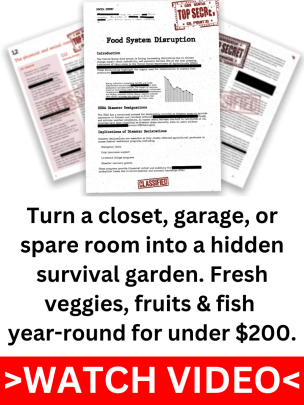Growing your medicinal plants is more than just a satisfying hobby; it is a strategy for maintaining your health and independence. Consider going outside and picking fresh herbs to soothe a headache, cure a burn, or boost your immune system. For prepper and survival enthusiasts, having a medical garden at home might be a game changer when modern medicine is unavailable.
Having your natural remedy supplies, especially during an emergency, ensures that you are not reliant on pharmacies or retail enterprises. This expertise delivers both practical benefits and peace of mind by ensuring that you have a sustainable source of treatments growing in your garden. Furthermore, planting medicinal plants is surprisingly straightforward, so even individuals with little gardening knowledge can get the benefits.
The Basics of a Medicinal Garden
Why grow medicinal plants at home? A medical garden allows you to create natural remedies for common ailments, enabling self-sufficiency and peace of mind. Growing your own medicine is an essential skill for preppers and survivalists. Whether it’s calming chamomile tea after a long day or applying aloe vera to a burn, these plants keep you ready for minor health issues without leaving your house. Aside from pragmatism, knowing you can rely on yourself for such basic resources brings immense joy.
A therapeutic garden cannot be started without soil, sunlight, and water. Understanding your plants’ basic needs is the foundation of any successful garden. The majority of medicinal plants like fertile, well-drained soil. If your garden soil is dense or clay-like, consider adding compost or sand to improve its texture and fertility. Another crucial issue is sunlight; most medicinal herbs require at least six hours of direct sunlight per day. While regular watering is essential, overwatering can promote root rot, particularly in drought-tolerant plants such as lavender. Check on your plants regularly so that you may adjust their care to meet their specific needs.
Tips for designing a garden and selecting plants that are both useful and aesthetically pleasing: A well-designed garden can be low maintenance and visually pleasing in addition to being functional. Grouping plants with similar needs together makes care much simpler. For instance, you can plant sun-loving and drought-tolerant plants like lavender and echinacea in the same section of your garden. On the other hand, darker, shaded conditions might be ideal for plants that thrive on moisture, like peppermint. Consider using raised beds for better soil drainage and accessibility. If space is a concern, vertical planting or container gardening are excellent ways to grow a variety of herbs even on a small porch.
Top Medicinal Plants and Their Benefits
Aloe Vera

Aloe Vera is ideal for arid climates since it thrives on sandy soil that drains quickly and requires little water. It can tolerate some shade, but it should be planted in full sun. If you live in a colder climate, grow aloe vera in containers and bring it indoors during the winter. To prevent root rot, make sure the pot has enough drainage holes. This succulent is prone to waterlogging, so do not overwater it. For the greatest results, utilize cactus or succulent-specific soil.
Aloe Vera gel is excellent for treating cuts, burns, and skin irritations. Its antimicrobial and anti-inflammatory properties help heal wounds. When eaten in moderation, aloe vera juice can aid digestion and alleviate constipation.
Chamomile
Chamomile prefers full sun but may take moderate shade, making it excellent for a range of garden situations. To get the greatest results, plant seeds directly in the soil in early spring. The plant thrives in well-drained, sandy, or loamy soil. Keep the soil moist but not excessively wet, particularly during the early stages of growth. Deadheading spent flowers can encourage more blooming. Chamomile can also be grown in pots in certain circumstances.
It is well known that chamomile tea has soothing properties and can help with anxiety and insomnia. Its anti-inflammatory effects aid digestion and soothe skin irritations. Additionally, the dried flowers can be utilized in infusions or poultices to provide mild antibacterial properties.
Peppermint
Peppermint is a robust plant that prefers damp, nutrient-rich soil. Although it can take direct sunlight in cooler locations, it prefers partial shade. Because of its aggressive spreading habit, it should be grown in pots. To ensure healthy plants, apply organic compost to the soil and maintain it moist at all times. Pruning the plant regularly encourages new growth and prevents it from becoming too woody.
Digestive distress, such as bloating, gas, and indigestion, can be greatly alleviated by peppermint. The soothing effect of its menthol component helps ease muscle soreness and headaches. Tea can be made from fresh leaves, and the essential oil can be administered topically (diluted) for its relaxing properties.

Echinacea

Echinaceas thrive well in soil that drains well and receives full light. It is a low-maintenance garden addition that, once established, can tolerate drought. Plant Echinacea 1-2 feet apart in the spring or fall to allow for airflow. Use a balanced fertilizer throughout the early stages of growth, but avoid overfertilizing as this could harm the plant. Deadhead spent blooms to extend flowering, but leave some seed heads for animals or reseeding.
By fortifying the immune system, echinacea helps the body fend against infections and colds. Additionally, it has anti-inflammatory properties that could lessen respiratory disease symptoms. Use the roots, leaves, and blooms to make tinctures or drinks that will strengthen your immune system.
Dandelion
Although they may grow in a variety of soil types, dandelions favor sunny spots with soil that drains properly. They can be grown by planting seeds in the early spring. Regularly thinning the plants encourages their healthy growth. If you wish to consume chemical pesticides or fertilizers, stay away from utilizing them. While the roots are finest unearthed in the fall when the medicinal compounds are at their greatest, the leaves can be picked young for salads.
Dandelion is a natural detoxifier that benefits both the kidneys and the liver. In addition to being high in vitamins and minerals, it has diuretic properties that help remove impurities. The dried roots have digestive benefits and can be used as a coffee replacement.
Lavender
Full sun and slightly alkaline, well-drained soil are ideal for lavender. Plant it in elevated beds or areas with enough air circulation to prevent fungal issues. Pruning should be done every year to maintain the plant’s shape and promote strong blooming. Lavender requires regular watering throughout its first growth season, but once established, it can withstand drought. Sand or gravel can be added to the soil mixture to help with drainage.
The calming properties of lavender are well known for encouraging rest and sleep. Tea, sachets, or essential oil extraction for aromatherapy can be made from its flowers. Applying lavender oil topically can help soothe minor burns and bug stings.

Growing Tips for Success
For medicinal plants to survive and provide the most advantages, proper care is essential. You may establish a successful garden by tailoring your approach to the individual needs of each plant.
While some medicinal plants need moderate shade, others thrive in bright sunlight. The makeup of the soil is also crucial; whereas herbs like chamomile grow best in loamy, nutrient-rich soil, plants like aloe vera need sandy, well-drained soil. A healthy growth cycle is encouraged by being familiar with these preferences.
Pest control is another important aspect of maintaining a medical garden. Despite the apparent effectiveness of conventional pesticides, you can protect your plants without compromising their medicinal characteristics by using natural remedies like neem oil, companion planting, and beneficial insect introduction.
Click Here for Survival Recipes With Wild Ingredients
You need to prune and harvest your garden on a regular basis to keep it productive. You can encourage your plants to focus their energy on producing potent medicinal compounds by pruning off excess growth and deadheading flowers.
Finally, pay attention to seasonal variations. Although many medicinal plants are perennials, harsh weather may demand extra care, such as mulching or bringing potted plants indoors.
Preparing and Using Your Medicinal Plants
Medicinal plants are versatile and can be used in many different ways, from tinctures and teas to salves and syrups. You can maximize their benefits if you know how to prepare and use them.
Teas are the easiest way to take medicinal plants like chamomile and peppermint. Collect fresh or dried flowers and leaves, soak them in hot water, and then enjoy their therapeutic effects.
Tinctures require a bit more preparation. The plant material is steeped in glycerin or alcohol to extract concentrated medicinal properties. This method is particularly effective for plants such as Echinacea and elderberries.
Balms and salves work best when applied topically. Infuse oils with medicinal plants like calendula or lavender, then mix the infused oil with beeswax to create a soothing ointment.
Your herbs must be thoroughly dried before being stored in order to retain their effectiveness. Keep them in airtight containers in a dark, chilly location to extend their shelf life.
You may get more out of your medicinal garden by experimenting with recipes like skin-soothing balms and immunity-boosting syrups. In addition to being good for your health, these crafts also make excellent presents for loved ones.
Growing medicinal plants in your garden is more than simply a practical endeavor; it is a step toward self-sufficiency and good health. Growing these plants not only provides treatments but also allows you to address minor health issues without relying on other sources. Begin with a few plants, such as Aloe Vera for burns, chamomile for relaxation, or lavender for stress relief, to entirely transform your attitude to natural treatment.
You do not need a vast garden to begin. A small container garden on your patio or balcony could make a major difference. As your confidence grows, you may expand your medical garden to include a wider selection of plants, ensuring that you’re prepared to face whatever challenges life throws at you.
Now is the moment to start. A medical garden is an invaluable tool for independence, health, and peace of mind, regardless of your level of prepping experience or understanding of the survival mindset.





















